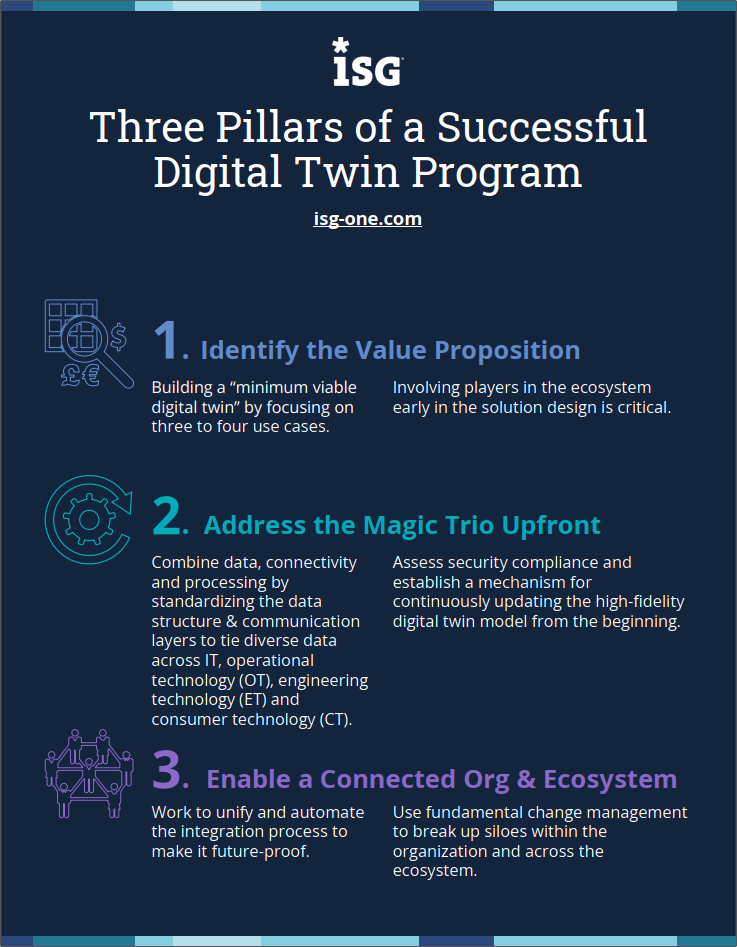To ensure your digital twin initiatives achieve business outcomes, we suggest building three essential pillars.
1. Identify the value proposition of a digital twin initiative.
This is a cornerstone of your digital twin program, as it affects the subsequent components. It is often neglected in many organizations, especially in environments where digital twin applications have proliferated from the “bottom up.”
Typical blind spots in achieving this goal include:
- Missing a wider stakeholder alignment on business value
- Failing to identify which processes and workflows are affected; which new roles, skills and governance mechanism are needed to track the progress/ value realization
- Identifying and involving too late external partners that can provide solutions regarding data collection, storage, analysis and the software and platforms for data management.
Recommendation: Whether you are addressing greenfield or brownfield scenarios, start by focusing on three to four use cases in which businesses and customers would appreciate the value, and build a “minimum viable digital twin.” This allows an incremental approach, by demonstrating the benefits and thus delighting stakeholders and continuously improving. Involving players in the ecosystem early in the solution design is critical here.
2. Address the magic trio upfront and create a stage for continuous deployment.
Digital twins combine data, connectivity and processing. It’s critical to address this trio upfront at the solution design stage.
Typical blind spots include:
- Neglecting the data diversity, integration and privacy/cybersecurity issues that can pose critical challenges
- Locking the solution early with little-to-no room for a continuously evolving digital twin solution.
Recommendation: A common approach is to standardize the data structure and communication layers to tie diverse data across IT, operational technology (OT), engineering technology (ET) and consumer technology (CT). A unified, developer-friendly data model is the backbone of all digital twin implementations. For cybersecurity, in addition to deploying internal safeguards, be sure to assess what security responsibility the partners are owning and ensure the digital twin implementation will not endanger enterprise systems.
Another critical step is to establish a mechanism for continuously updating the high-fidelity digital twin model from the beginning. In scenarios in which knowledge of the digital twin deployment environment is unknown, you want an incremental approach to improve digital twin maturity, as more real-world data is integrated into it.
3. Enable a connected organization and ecosystem.
Digital twin technology can be a game-changer in today’s secured, intelligent, connected economy. It does so by creating value for end users and finding business models that allow profit-making for various ecosystem players.
A typical blind spot here is the lack of a standardized and proven mechanism for secure data-sharing across ecosystem players, including companies, customers, suppliers and contractors. While digital twin standards are emerging, the required pull / acceptance from the end-users and markets will determine which standards bring business value. Companies tend to make the mistake of getting engineers and data scientists into a room, focusing on digital twin standards and protocols and then writing custom code.
Recommendation: While exploring emerging innovative and sometimes open-source technological solutions in the market, especially in the data management and integration space, can be helpful, the integration platforms need to go one level deeper. Work to unify and automate the integration process to make it future-proof. Results here are made better by trying to make the least possible number of assumptions about the evolving use cases in the secure, intelligent, connected economy. Don’t forget that it requires fundamental change management to break up siloes within the organization and beyond, in the ecosystem, to impart new skills, processes and governance required for digital twin deployments.
To learn more about Digital Twin, its evolution journey and its use cases, read more in our article “Digital Twin: A Foundation for a Secure, Intelligent and Connected Enterprise” and download our full report.

